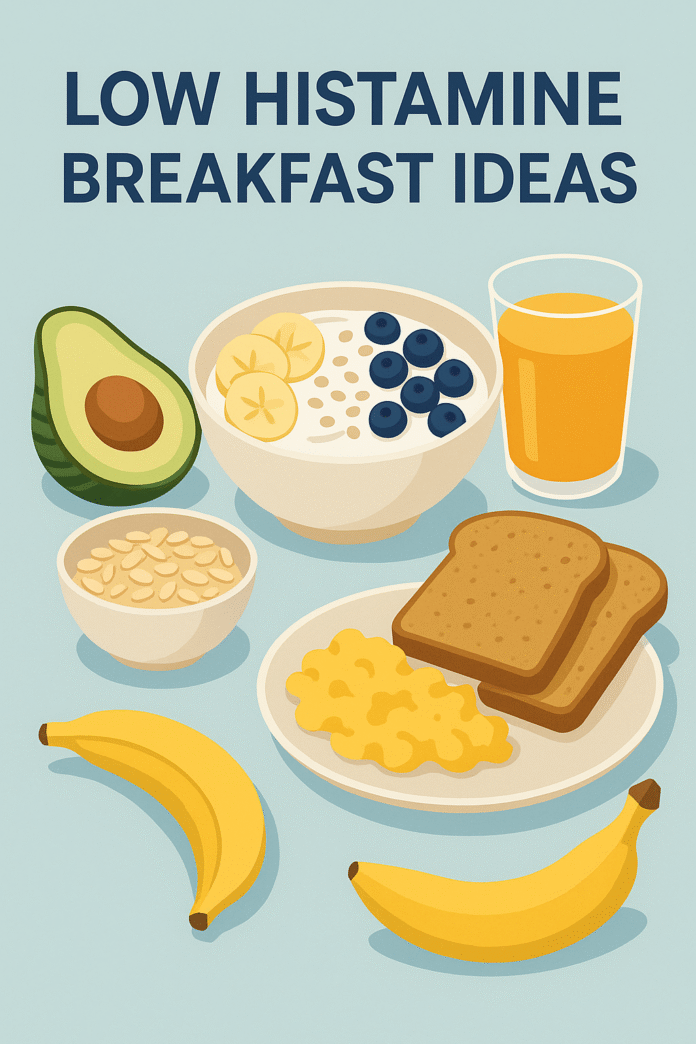Introduction – What This Article Covers
If you struggle with histamine intolerance, finding suitable breakfast options can feel overwhelming. Many common breakfast foods are high in histamines or trigger histamine release, making mornings challenging. This article provides a comprehensive guide to low histamine breakfast ideas that are safe, nutritious, and delicious. We’ll explore what histamine intolerance is, why it’s important to manage it, and offer practical, step-by-step ideas to create a satisfying breakfast routine.
What is Low Histamine Breakfast?
A low histamine breakfast consists of foods that contain minimal histamine or do not trigger histamine release in the body. Histamine is a naturally occurring compound involved in immune responses, but excessive histamine can lead to a variety of symptoms like headaches, hives, digestive issues, and fatigue. histamine intolerance lack sufficient levels of the enzyme diamine oxidase (DAO), which helps break down histamine, leading to these reactions.
Why is Low Histamine Breakfast Important?
Starting your day with a low histamine meal helps stabilize your body’s histamine levels from the get-go, reducing the likelihood of symptoms throughout the day. According to the Cleveland Clinic, breakfast sets the tone for energy levels, digestion, and overall well-being. By carefully choosing your morning meals, you can minimize histamine exposure and better manage your condition.
Benefits of Low Histamine Breakfast
- Reduces Symptoms: Minimizes headaches, skin reactions, and digestive issues.
- Boosts Energy: Stabilizes blood sugar levels, reducing fatigue.
- Improves Digestion: Helps maintain gut health by avoiding trigger foods.
- Supports Immune Function: Decreases unnecessary immune responses.
- Enhances Mental Clarity: Reduced brain fog and better focus throughout the day.
How to Do Low Histamine Breakfast – Step-by-Step Guide
Step 1: Know Your Safe Foods
Start by identifying foods generally considered low in histamine. As explained by the National Institutes of Health (NIH), some safe options include:
- Freshly cooked eggs (avoid aged or processed forms)
- Gluten-free oatmeal
- Quinoa
- Rice cakes
- Fresh fruits like blueberries, apples, and pears
- Fresh vegetables like spinach and zucchini
- Non-dairy milk alternatives like oat milk or coconut milk (check for additives)
Step 2: Plan Your Meals
Planning ahead ensures you have the right ingredients and reduces the temptation to reach for high histamine options. Example meal plans:
- Oatmeal with Blueberries: Gluten-free oats cooked with coconut milk and topped with fresh blueberries.
- Egg and Vegetable Scramble: Fresh eggs scrambled with spinach and zucchini.
- Quinoa Porridge: Cooked quinoa with pear slices and a drizzle of honey (if tolerated).
Step 3: Prepare in Advance
Batch-cook and prep ingredients to save time in the morning. Wash and chop fruits, pre-cook grains, and portion out servings in advance.
Step 4: Monitor Reactions
Keep a food diary to track any reactions and adjust your meal plan accordingly. Everyone’s tolerance is different.
Common Mistakes to Avoid
- Using Leftovers: Histamine builds up in food over time. Always eat freshly prepared meals.
- Aged or Fermented Foods: Avoid aged cheeses, cured meats, and fermented products.
- Processed Foods: Check labels for preservatives and additives that may trigger histamine release.
- Assuming All “Healthy” Foods Are Safe: Foods like avocados, bananas, and tomatoes are healthy but high in histamine for sensitive individuals.
- Skipping Meals: Irregular eating patterns can stress the body and exacerbate symptoms.
Expert Tips for Better Results
- Invest in Quality Ingredients: Use organic, fresh produce whenever possible.
- Stay Hydrated: Drinking plenty of water helps flush histamine from your system.
- Consider DAO Supplements: Some people benefit from supplements that support histamine breakdown, as supported by findings from the NIH.
- Consult a Nutritionist: Work with a professional to customize your diet.
- Keep it Simple: Focus on a few safe, enjoyable meals and rotate them.
FAQs – Frequently Asked Questions
Q1: Can I drink coffee on a low histamine diet? A: Coffee can trigger histamine release in some individuals. Opt for herbal teas like chamomile or ginger if you are sensitive.
Q2: Are eggs safe for low histamine breakfast? A: Freshly cooked eggs are generally well-tolerated, but avoid processed forms like powdered eggs or pre-cooked egg dishes.
Q3: What fruits are best for low histamine breakfast? A: Blueberries, apples, pears, and watermelon are usually safe choices.
Q4: Is oatmeal safe on a low histamine diet? A: Gluten-free oats are typically well-tolerated. Always prepare them fresh.
Q5: Can I eat bread for breakfast? A: Most commercial breads contain yeast and preservatives that can increase histamine. Look for freshly baked, yeast-free, and preservative-free options.
Q6: Should I avoid all dairy products? A: Aged cheeses are high in histamine. Fresh dairy, like plain yogurt made at home, may be tolerated by some individuals.
Conclusion – Final Thoughts
Managing histamine intolerance doesn’t mean sacrificing a satisfying breakfast. With careful planning and fresh, simple ingredients, you can enjoy delicious low histamine breakfasts that support your health and well-being. Always listen to your body, track your responses, and consult healthcare professionals as needed.
